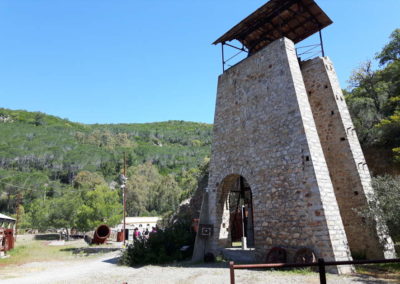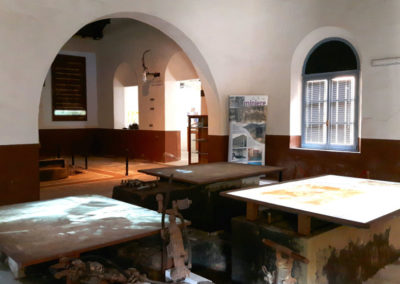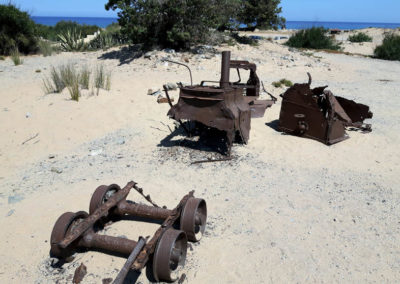Former guest quarters. Museum of Dioramas
Dellacà Collection
The guest house was the accommodation for engineers and managers of the mine; built around 1930, it was closed in 1991 together with all mining activities. The building has three levels, each of about 600 square metres. The basement, with internal and external access on one side of the building, houses a series of service rooms (cellars and warehouse) distributed along a central corridor. The ground floor has three direct entrances from the outside of which, the one on the main facade, leads to an entrance. From here there is access to a corridor that runs the entire length of the building, distributing the guest quarters on both sides. At the bottom of the entrance, a stairwell gives access to the upper floor, which is also arranged according to a logic of accommodation with entrance from the central corridor. The guest quarters currently house, in some of its rooms, a splendid collection of dioramas (Dellacà Collection) reproducing the mining life in various periods.
HISTORY OF THE MONTEVECCHIO MINE
The history of the Montevecchio mine dates back to very ancient times; the deposit was known as early as 1600 BC. The first outcrop of the vein to the east dates back to Roman times. Mineral deposits are clusters of useful minerals, which must be found in sufficient quantity to justify industrial exploitation. Normally, a mineral is not found in its pure state, but accompanied by rock called „gangue“’, which must be separated before it can be exploited. The Montevecchio lead-silver deposit has been mined and exploited for centuries. In 1848, King Carlo Alberto signed the first concession to Giovanni Antonio Sanna for the industrial extraction of the mineral. Kilometres of tunnels, shafts and furnaces connected the various levels of the mines. Lead, silver, zinc, and even small amounts of gold were extracted.
Since the dawn of civilisation, Sardinia has been identified as a „rich producer of metals“. There are no areas that have not been affected by some small-scale mining operations over the centuries in search of metal deposits or ornamental stones. It was a black and shiny stone, a volcanic glass called obsidian, that guaranteed a stable presence in Sardinia for Neolithic men. With the use of obsidian, probably as early as the sixth millennium B.C., began the mining, processing and commercial activity that, starting from Monte Arci, has progressed up to the present day and still continues. Metalworking reached its peak with the development of the Nuragic civilization.
Sardinia had only one truly great industry: mining. The richness of its soil was immense and tempted all the populations that landed on its coasts, from the Etruscans to the Punics, the Romans, the Iberians, the Pisans and the Genoese. We can say that the first miners were the men of the recent Neolithic period, who did not really dig, but simply searched in the ground for certain ductile stones, such as obsidian (a glassy stone of volcanic origin), granite or quartz, which were used to make tools for hunting or for defence against enemies.

MONTEVECCHIO YESTERDAY AND TODAY
The mining hamlet of Montevecchio is situated within the municipal territories of Guspini and Arbus, enclosed between the mountains of the Iglesiente chain that slope westwards into the clear sea of the Costa Verde and the Campidano plain, that you can see if you look eastward .
The natural context is unique due to the presence of woods of holm oaks, downy oaks and cork oaks. Montevecchio owes much of its fame and importance to its mining past, which make it a prestigious example of industrial archaeology in Italy.
ABOUT THE HISTORY OF THE MINE
The history of Montevecchio has traces of human settlements dating back to the most ancient times, and finds confirm that the area was known in pre-Nuragic, Nuragic, Punic, Roman and medieval times.
Some reports date the first ‘mining’ concession back to 1600, but it was only two centuries later that Don Antonio Pischedda realized the importance of the site and founded a mining company with Giovanni Antonio Sanna from Sassari. In 1848 he obtained from King Carlo Alberto a perpetual concession for the exploitation of the Montevecchio mine. Under the guidance of Sanna, who invested all his capital, the mine developed around the Pozzo Sant’Antonio (Shaft Sant’Antonio) and the Laveria Rio (Washery Rio). In a short time, the Montevecchio mine became so important in the kingdom, that in 1865 it could count on 1100 workers.
The Montevecchio mine should also be remembered for the numerous innovations that were introduced for the first time in Europe. These include the internal and external electrification of the mine, the new drilling systems (which switched from the dry method to the water method, thus reducing the health risks for workers) and finally the invention of the shovel truck. The great adventure of the Montevecchio mines ended, from the mining point of view, in 1991 with a large workers’ demonstration and the occupation of the Amsicora pit.
TODAY
After the closure of the Montevecchio and Ingurtosu mines, the area received promises of new forms of development that were supposed to employ the many former miners who had been left without work. Today, Montevecchio has taken only a few initiatives that are struggling to get off the ground, but which are the only positive example of the reconversion of a territory.
The administrative division of Montevecchio between Arbus and Guspini didn’t aided the various initiatives undertaken. The municipality of Arbus, through funding, restored and recovered several buildings that had belonged to the mining company. Among the restored buildings you can visit the geological centre, the executive lodging and the Pozzo Amsicora. The geological office houses the museum, opened in 2010, dedicated to the Sanna Castoldi family, remembered for making the Montevecchio mines famous throughout Europe. After an initial donation, the collection was expanded to include other precious objects belonging to the Sanna Castoldi family.
The executive lodging houses the prestigious collection of Dellacà dioramas, which retrace the evolution of mining history through the precious artistic creations of Raffaello Sanfilippo. The famous Hall of Mirrors houses the mineral museum, with exhibits from the Montevecchio mines and many other parts of the world. The Pozzo Amsicora, a symbol of the last workers’ struggles, was restored, respecting the beauty of the structure.




